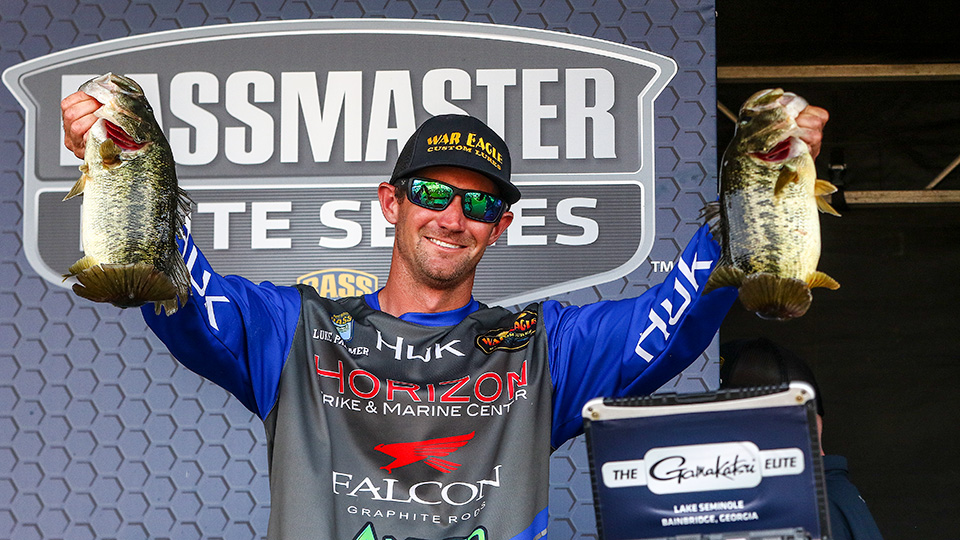
As water temps rise so does the need to use big baits. Elite Series pros offer the best options for every level of the water column to wrangle a PB right now
When spring’s warmth advances into summer’s heat, bass behavior typically shifts to a more comfort-centric priority as depth and current come to the forefront. Five Elite anglers shared their insights into how they track down and engage June giants.
Luke Palmer — Southern Reservoir

The waters of Lake Texoma, which straddles the border of Texas and Luke Palmer’s home state of Oklahoma, hold a healthy population of big fish that can make a day memorable — but rarely easy. To tap into this potential, he gets right to the point.
“I’ll start by looking for a morning topwater bite with a Zara Spook on points with a couple of big, isolated rocks,” Palmer said. “When I’m getting up into the day, I’m going to go find isolated trees, isolated brushpiles or maybe a dock by itself in 8 to 12 feet of water.”
Such scenarios, Palmer said, define the territorial nature inherent in every big bass. They’ve staked out the ideal blend of concealment and ambush-feeding potential; they’re not going to give it up; and they’re going to eat anything foolish enough to wander close.
“That’s their home; they’re not roaming around chasing shad,” Palmer said. “Those big ones want to be sitting beside something.”
The key here is realizing that the attraction to this cover outweighs appetite. Knowing this, Palmer’s going to tempt these fish with a slow, methodical presentation.
Having caught Texoma bass up to 9 pounds, Palmer attacks these isolated cover points with a 10-inch Yum Ribbontail worm in a plum color. He’ll rig this big bait on a 3/0 straight-shank hook with a 1/4- to 3/8-ounce Rougarou Tungsten weight.
“I don’t want a weight any bigger than that because it’s going to fall too fast,” Palmer said. “I still want a natural presentation, but I want it to get down and stay in contact with the bottom.”
Palmer throws his big worm on a 7-3 Falcon Cara Amistad rod with a 7.5:1 reel carrying 16- to 20-pound Sunline Shooter fluorocarbon.
On the approach, Palmer’s mindful of the typically discerning attitude a big fish holds.
“The main thing about fishing for those bigger fish is that they’re not likely to bite on the first cast; you’ll usually have to make several presentations from different angles,” Palmer said. “If you have a good brushpile that’s been there for a while, you might have to let that worm soak for 15 to 20 seconds until everything settles and then just barely move it.”
Greg Hackney — Southern Tidal Waters
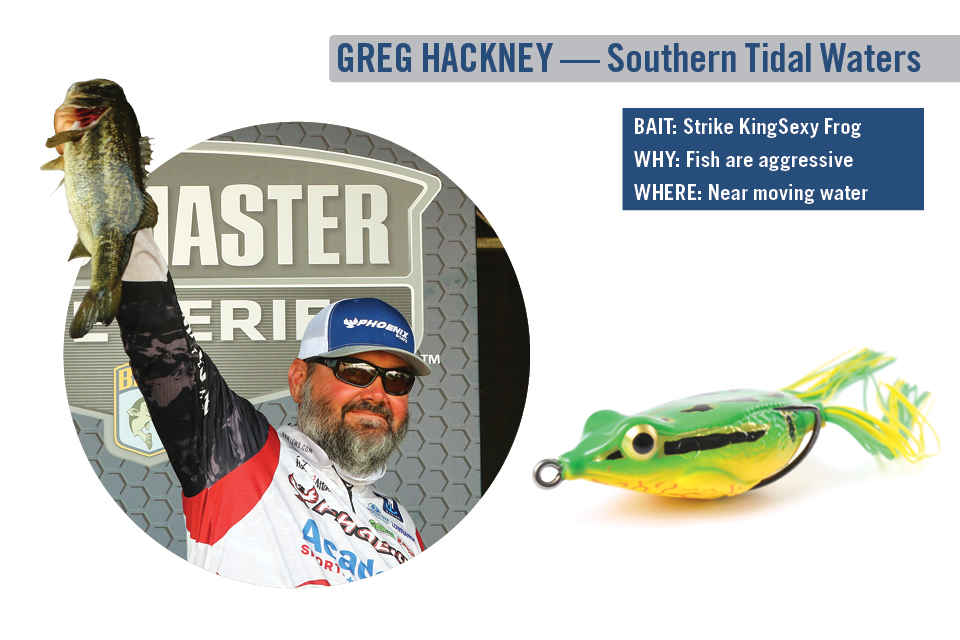
Greg Hackney said June typically finds his southern Louisiana fish moving away from the marsh ponds and dead-end canals where they had recently spawned. That’s why he points to the mouths of these areas as the transitional spots with giant potential.
“I’ll be looking for moving water because it’s already hot here in June,” Hackney said. “They’ll just be moving to current — whether that’s wind-driven current, tide-driven current or natural bayous.”
This general scenario will attract and hold fish all day, but Hackney’s a big fan of low tide, specifically the last couple of hours of outgoing water.
“Our fish are so conditioned to [tidal fluctuation], because when everything starts to condense, it’s the dinner bell,” he said. “The instant all the life is pulled together, it’s just a trigger for those fish to feed.”
Early and late in the day Hackney likes a Strike King Sexy Frog, while a Strike King Tour Grade Buzzbait excels in windy conditions. During the heat of the day, he’s dragging key spots with a Strike King Hack Attack Heavy Cover Jig with a water-moving trailer like the Strike King Rage Lobster, Game Hawg or Rage Magnum Bug.
“This is one of the places where big baits catch big fish,” Hackney said. “Typically our water is off-colored and you’re dealing with an aggressive species of bass, which seems to get excited about a bigger bait.
“I don’t usually have to finesse fish this time of year. If we were talking about August or September, that’s a totally different deal. But in June, the water’s hot and the fish are still aggressive.”
As Hackney explained, the transition from postspawn to the dog days of summer finds the fish feeding heavily and readily attacking beefy baits. The last one he offers for this current-related falling-tide scenario is a Texas-rigged Strike King Rage Anaconda.
“A lot of times, you’re not fishing in the cover, but you’re fishing around it,” Hackney said. “When fish are around cover, there’s just something about that big worm at the end of the postspawn period. Regardless of what part of the country you’re in, that is a big-fish bait.
“I’ve flipped up some big fish, but the biggest strings of fish I’ve caught and some of the biggest bass I’ve caught came on a big worm. That’s something I have a ton of confidence in [during] the early summer for catching big bass.”
Clark Wendlandt – Standing Timber Lake
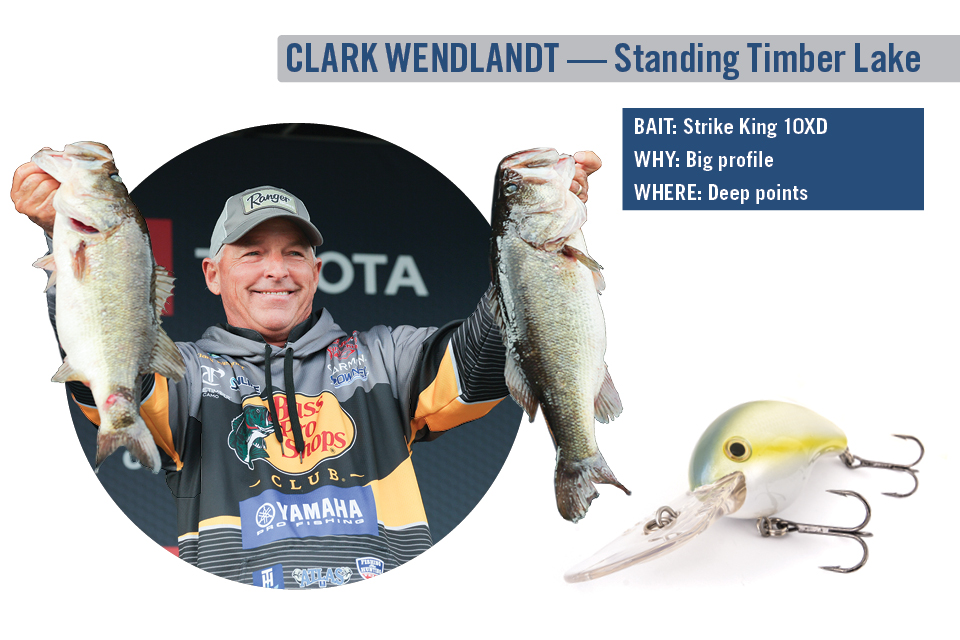
Tackling a lake filled with standing timber, it’s easy to get sucked into a wood-centered focus. That’s not necessarily wrong, but Clark Wendlandt simplifies the process by devoting more of his attention to bottom contour and selecting areas that would likely interest summer bass, with or without the timber.
“Usually, I feel like big fish are somewhat associated near deep water, so I’m going to look for places that are close to a creek channel,” Wendlandt said. “Then, I’d look for where deep water hits along the side of a submerged point, where deep water comes up on bank or where a shallow spot has deep-water access. The whole key is deep water.”
Wendlandt values each of these scenarios, but he favors points with deep-water access because these scenarios allow fish to move up, feed up and then slide out to deeper areas where they’ll nap away the hot hours in suspended solitude. Any point could possibly hold fish, but the true toads are very particular about where they set up shop.
“Not all points are created equal, and the ones I’m going to look for have a hard spot on them — a little gravel, a little rubble, a little rock,” Wendlandt said. “And usually what I’m talking about is a submerged point — something you can see on your mapping and not necessarily with your eyes.”
For the summer months Wendlandt expects a morning bite, and that early action will offer a clear indication of the spot’s merit. Midday visits might offer a few opportunities, but cracking a couple of big fish early shows him the quality potential.
Wendlandt’s going to crank the attractive spots with a Strike King 10XD retrofitted with size No. 1 Owner 2X ST-41 hooks. He’ll throw this bait on a 7-10 heavy Bass Pro Shops cranking rod with a 6.8:1 Bass Pro Shops Johnny Morris Platinum Signature Series reel carrying 18-pound Sunline Sniper fluorocarbon.
“You’re dealing with a big fish in a timbered lake, and if that bait gets hung, this tackle gives me a better chance to get it unhung,” Wendlandt said. “I’m making long casts, because you don’t get the bait down very deep if you make a short cast.”
Important to note: While Wendlandt’s not actually targeting the standing timber, this structure demands consideration. He uses his Garmin LiveScope to identify presentation lanes.
“You need lanes, because if you’re coming over limbs of trees, your bait’s never reaching bottom.”
KJ Queen – TVA Lake
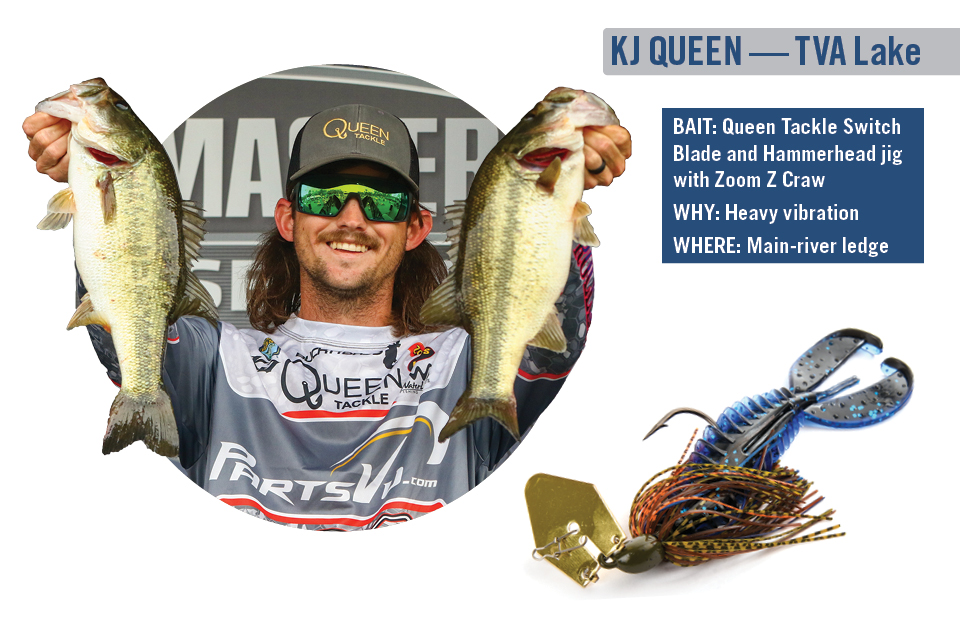
While June may find some of the later postspawn fish still putzing around in the shallows, third-year Elite KJ Queen knows his most consistent big-fish opportunities await offshore, either on a main-river or secondary ledge. Diversifying his presentations, Queen will show the fish two distinctly different looks until he determines the daily mood.
Queen has built his own line of baits for several years now, so his go-to is a Queen Tackle Switch Blade on a 3/4-ounce Queen Tackle Hammerhead Jig with a full-size Zoom Z Craw trailer. Creating a bold, obnoxious intruder is the objective, and when this bladed jig package passes a big one, it’s not going unnoticed.
“That trailer gives the [bladed jig] a really big profile, and with that Switch Blade on that tungsten head, it gives off a [unique] sound,” Queen said. “I’ll rig that trailer turned sideways, for a bream or crappie profile, not flat for a crawfish profile.
“I like how the Z Craw gives off a lot of heavy vibration and makes the blade work really hard. I think that’s the key to getting a pure reaction bite. If I can’t get them to fire, I’ll switch over and throw a Texas-rigged Zoom Mag Speed Worm.”
Queen’s best presentation is a long cast and a patient pause that allows the bladed jig to fall to the bottom. He’ll start by slow rolling the bait until he determines it’s game-on.
“If I either catch one or get them fired up, I’m going to yo-yo it and rip it off the bottom,” Queen said. “I’ll rip it up 8 to 10 feet, let it fall back down, [then repeat].”
Queen likes a sunny day, as the bright skies tend to group the fish tighter on a ledge, whereas a cloudy day usually finds them loosening their relation to the bottom structure. This is important because the big fish usually eat first, and the tighter the school, the more likely his bait catches a giant’s eye.
“Usually, your first or second cast through the school is when you’re going to catch your biggest fish,” Queen said. “I like switching up colors to imitate a shad or a bream. I’ll alternate between a green pumpkin/green Hammerhead, which is a crawfish- and bream-imitating bait, and I’ll put a green pumpkin Z Craw on the back.
“For a shad look, I’ll throw a gizzard shad-colored Hammerhead with a solid white Z Craw on the back of it.”
\
Micah Frazier — Herring Lake
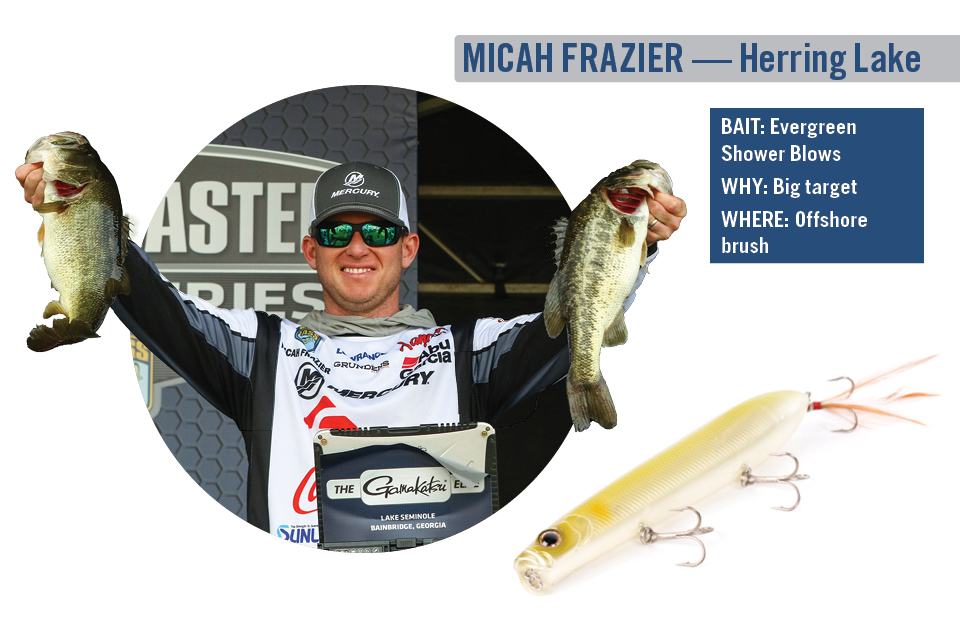
Blueback herring are game changers, and Micah Frazier knows that wherever these neurotic baitfish occur, the majority of the lake’s bass adjust their lifestyles. A hefty meal, the blueback is a mouthful worth pursuing, but anglers simply must play the game by the fish’s rules.
“Blueback herring are a pelagic baitfish, so they stay out in the main body of the lake and roam,” Frazier said. “They don’t relate to any structure; they just roam, so they pull the fish out there to relate to structure adjacent to the highways the baitfish use.
“Instead of fish relating to stuff near the bank, you get fish that sit out on the ends of points and use timber and brushpiles more so than [in] a lake that doesn’t have herring.”
Largemouth eat plenty of bluebacks, but this deal pairs well with spotted bass, which are already wired for a largely offshore life. That being said, Frazier points to brushpiles and cane piles as stellar summer targets.
“That’s the time of year you get that topwater action over brushpiles in 20 to 30 feet, and you get to see those fish come up out of the depths and eat a bait,” Frazier said. “That time of year, I would lock a walking bait in my hand and target brush on shoals and points.”
The good thing about this technique is it raises a lot of fish. The bad thing — ditto. Frazier doesn’t like burning time weeding through scads of little ones, so he throws sizable baits that tend to appeal more to the bigger spots.
His favorites are the Evergreen Shower Blows and the Ima Little Stik 135, both in chrome. A 10:1 Abu Garcia Revo Rocket affords Frazier the speed to quickly reel up for a new cast to breaking fish, as well as the pace needed to tempt herring-focused spots.
Frazier complements his topwater presentations with a Megabass Vision Oneten jerkbait in French pearl with an orange belly. That underside accent, he said, helps the fish spot a less boisterous bait when the surface show isn’t working.
“I work the topwater and the jerkbait really fast. You don’t want to stop your bait at all. If you get a follower or one that’s trying to eat your topwater bait, if you stop it, they lose interest. But if you take it up a notch and keep it moving, it drives them crazy and they’ll stay after it until they get it.
“By locking the bigger baits in your hand, you cut out some of the smaller fish,” Frazier said. “But you’ll start to see a pattern of what depth the bigger fish are using or what presentation they want.
“It’s just important to get keyed in on what the larger fish want that day and not get caught in the trap of just throwing a drop shot and just catching 1 1/2- or 2-pounders and hoping you get lucky. By using bigger baits, you take yourself out of the lottery for getting a lot of bites, but you enter the world of having a chance at catching a real giant.”
Originally published in Bassmaster Magazine 2023.






